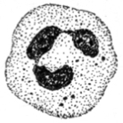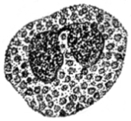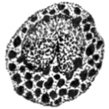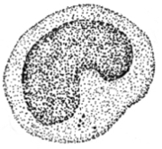| Table 7.1. Leucocytes |
Version française
[7.1. Leukocytes]
|
 |
Neutrophil
- Lobed nucleus (2-6 lobes). Lobes show condensed basophilic flakes of chromatin.
- Pale cytoplasm with fine dusty granules (less than 0.3 µm).
- Occasionally contains deeply stained azurophilic (lysosomal) granules (0.3-0.5 µm).
- This cell is ameboid, phagocytic and chemotactic (i.e., it responds to attractive chemical substances).
|
 |
Eosinophil
- Bilobed nucleus with partially condensed chromatin.
- Cytoplasm contains numerous large (0.5µm or larger) orange acidophilic granules. (The cytoplasm may also contain a few azurophilic granules).
- This cell is chemotactic, ameboid and endocytic but not phagocytic. It responds to parasitic infections and allergens.
|
 |
Basophil
- Bilobed nucleus with partially condensed chromatin.
- The cytoplasm contains large granules of various sizes (larger than 1 µm) and shapes. These granules, which are deeply basophilic or azurophilic, have properties of mast cells.
- This cell secretes heparin, histamin and vasodilator substances.
|
 |
Monocyte
- Large cell with a slightly indented, large nucleus containing partially condensed chromatin.
- Abundant pale blue or lightly basophilic cytoplasm.
- Occasionally contains azurophilic (lysosomal) granules and vacuoles.
- This cell is chemotactic, ameboid and phagocytic, and transforms into macrophages in the connective tissue.
|
 |
Medium lymphocyte
- Spherical or ovoid nucleus containing deeply stained flaky chromatin.
- Blue or basophilic cytoplasm containing a few azurophilic or lysosomal granules.
- This cell belong to the immune system.
|
 |
Small lymphocyte
- Small spherical nucleus (of the size of a red blood cell) with deeply stained condensed chromatin.
- Nucleus surrounded by a thin rim of basophilic cytoplasm free of azurophilic granules.
- This cell is ameboid but non-phagocytic and is involved in cellular immunity (in the case of T-lymphocytes of thymic origin) or in humoral immunity (in the case of B-lymphocytes of bone marrow origin).
|






![]() The text and images of this Histology Atlas, by Yves Clermont,
Michael Lalli & Zsuzsanna Bencsath-Makkai,
are licensed under
Creative Commons Attribution-Noncommercial-No Derivative Works 2.5 Canada Licence and cannot be modified without the written permission of the authors.
Use of any text or images must carry an acknowledgement which includes a link to the original work.
The text and images of this Histology Atlas, by Yves Clermont,
Michael Lalli & Zsuzsanna Bencsath-Makkai,
are licensed under
Creative Commons Attribution-Noncommercial-No Derivative Works 2.5 Canada Licence and cannot be modified without the written permission of the authors.
Use of any text or images must carry an acknowledgement which includes a link to the original work.